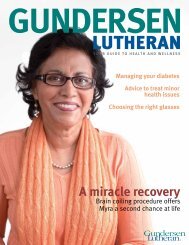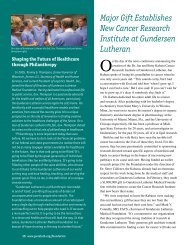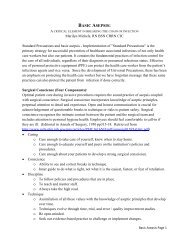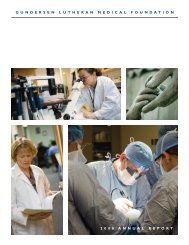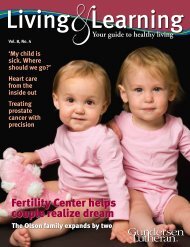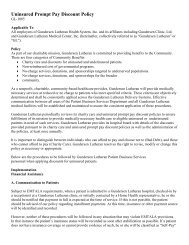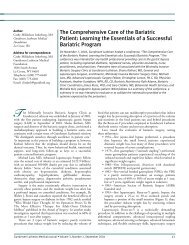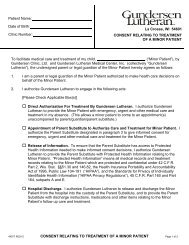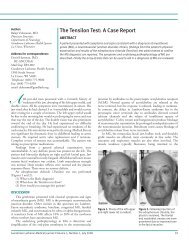ndersen er an - Gundersen Health System
ndersen er an - Gundersen Health System
ndersen er an - Gundersen Health System
You also want an ePaper? Increase the reach of your titles
YUMPU automatically turns print PDFs into web optimized ePapers that Google loves.
Authors:<br />
Alissa R. Rei<strong>er</strong>son<br />
D<strong>an</strong>iel D. Houlih<strong>an</strong>, PhD<br />
Minnesota State Univ<strong>er</strong>sity –M<strong>an</strong>kato<br />
M<strong>an</strong>kato, Minnesota<br />
Address for correspondence:<br />
D<strong>an</strong>iel D. Houlih<strong>an</strong>, PhD<br />
Psychology Department<br />
Office WH 261<br />
23 Armstrong Hall<br />
Minnesota State Univ<strong>er</strong>sity–M<strong>an</strong>kato<br />
M<strong>an</strong>kato, MN 56001<br />
Telephone: (507) 389-6308<br />
email: d<strong>an</strong>iel.houlih<strong>an</strong>@mnsu.edu<br />
Childhood Onset of Anorexia N<strong>er</strong>vosa<br />
ABSTRACT<br />
Extensive research conc<strong>er</strong>ning the presentation <strong>an</strong>d treatment of adolescents <strong>an</strong>d adults<br />
diagnosed with <strong>an</strong>orexia n<strong>er</strong>vosa c<strong>an</strong> be found within the lit<strong>er</strong>ature. Conv<strong>er</strong>sely, the research<br />
regarding early-onset <strong>an</strong>orexia is limited. Children presenting with <strong>an</strong>orexia n<strong>er</strong>vosa may<br />
display qualities <strong>an</strong>d exp<strong>er</strong>ience challenges disparate from those of their old<strong>er</strong> count<strong>er</strong>parts.<br />
This review of the lit<strong>er</strong>ature examines these diff<strong>er</strong>ences <strong>an</strong>d their signific<strong>an</strong>ce regarding the<br />
diagnosis, treatment, <strong>an</strong>d outcome of early-onset <strong>an</strong>orexia n<strong>er</strong>vosa.<br />
T<br />
he rates of individuals seeking treatment for <strong>an</strong>orexia<br />
n<strong>er</strong>vosa (AN) have risen in recent years. 1,2 This increase<br />
may be attributable more to the attention AN has received, rath<strong>er</strong><br />
th<strong>an</strong> to a genuine rise in the incidence of the disord<strong>er</strong>. Howev<strong>er</strong>,<br />
in conjunction with this increase in individuals seeking treatment<br />
comes <strong>an</strong> increase in prepub<strong>er</strong>tal individuals exp<strong>er</strong>iencing AN-type<br />
symptoms.<br />
It is estimated that early-onset AN accounts for nearly 5% of<br />
all AN cases. 3 Within the lit<strong>er</strong>ature, AN is consid<strong>er</strong>ed early-onset<br />
if individuals are 13 to 14 years old or are prepub<strong>er</strong>tal. 4-6 Only a<br />
small proportion of the eating disord<strong>er</strong>s lit<strong>er</strong>ature has addressed<br />
this young<strong>er</strong> population. 7,8 M<strong>an</strong>y studies fail to diff<strong>er</strong>entiate<br />
between early-onset <strong>an</strong>d late-onset AN, which may be problematic<br />
because of the diff<strong>er</strong>ences between early-onset <strong>an</strong>d late-onset AN.<br />
For example, compared with individuals with late-onset AN, those<br />
with early-onset AN are more likely to be male <strong>an</strong>d more likely<br />
to belong to families with high socioeconomic status. Individuals<br />
with early-onset AN also are usually physically <strong>an</strong>d psychologically<br />
less mature th<strong>an</strong> their pe<strong>er</strong>s. 4,9 These diff<strong>er</strong>ences are signific<strong>an</strong>t<br />
<strong>an</strong>d c<strong>an</strong> affect the diagnosis, course, <strong>an</strong>d treatment outcome. The<br />
following review will focus on diff<strong>er</strong>ences between early-onset <strong>an</strong>d<br />
late-onset AN with regard to diagnosis, charact<strong>er</strong>istics, physical<br />
risks, treatment, <strong>an</strong>d outcome.<br />
Discrep<strong>an</strong>cies in Diagnosis<br />
Anorexia n<strong>er</strong>vosa is the willful refusal to maintain a body<br />
weight that is within 85% of a healthy weight for <strong>an</strong> individual’s<br />
height <strong>an</strong>d age. Along with this refusal, people with AN display<br />
a fear of becoming ov<strong>er</strong>weight. 10 They make extreme attempts at<br />
avoiding weight gain, which may include <strong>an</strong> extremely restricted<br />
diet <strong>an</strong>d/or excessive ex<strong>er</strong>cising. Accomp<strong>an</strong>ying this fear of weight<br />
gain, individuals with AN don’t recognize that they are d<strong>an</strong>g<strong>er</strong>ously<br />
thin. Their p<strong>er</strong>ception of their body weight or shape is distorted.<br />
Consequently, they may be 15% or more und<strong>er</strong> their ideal weight,<br />
but still believe that they need to lose weight. 10<br />
The crit<strong>er</strong>ia for AN have been subject to much debate,<br />
especially for prepub<strong>er</strong>tal children <strong>an</strong>d those und<strong>er</strong> 13 years of<br />
age. 5 Conflicting reports on children’s presentation of AN are<br />
found within the lit<strong>er</strong>ature. Some research<strong>er</strong>s have found that<br />
children who are ref<strong>er</strong>red for AN-type symptoms often do not<br />
have a distorted body image. 11,12 Most of these children have not<br />
yet reached pub<strong>er</strong>ty <strong>an</strong>d may simply fear that they will gain weight<br />
as their bodies ch<strong>an</strong>ge. Th<strong>er</strong>efore, they do not necessarily believe<br />
they are currently ov<strong>er</strong>weight, yet they have gone to great lengths<br />
to not gain weight. 12 Consequently, the charact<strong>er</strong>istic distortion in<br />
body image, weight, <strong>an</strong>d shape may develop lat<strong>er</strong>, as children go<br />
through pub<strong>er</strong>ty <strong>an</strong>d their bodies ch<strong>an</strong>ge <strong>an</strong>d the social appeal of<br />
their appear<strong>an</strong>ce becomes a factor.<br />
Oth<strong>er</strong> diff<strong>er</strong>ences between early-onset <strong>an</strong>d late-onset AN have<br />
been noted, as well. 6 For example, Matsumoto <strong>an</strong>d colleagues<br />
found that few<strong>er</strong> early-onset th<strong>an</strong> late-onset AN patients had<br />
extremely low weight. 6 Similarly, oth<strong>er</strong>s have found that the<br />
av<strong>er</strong>age weight of children with early-onset AN was only 5% below<br />
their ideal weight. 11 This less sev<strong>er</strong>e weight loss may be because<br />
young<strong>er</strong> individuals are still in the early stages of AN. 11 Still oth<strong>er</strong><br />
research<strong>er</strong>s have found that children often lose weight more rapidly<br />
th<strong>an</strong> adolescents <strong>an</strong>d adults do. 7 P<strong>er</strong>haps because their weight loss<br />
occurs in a short<strong>er</strong> p<strong>er</strong>iod of time, <strong>an</strong>d because they are usually more<br />
sup<strong>er</strong>vised th<strong>an</strong> adolescents <strong>an</strong>d adults, young<strong>er</strong> children present<br />
to a physici<strong>an</strong> or psychologist earli<strong>er</strong> th<strong>an</strong> oth<strong>er</strong> AN patients do.<br />
Howev<strong>er</strong>, it should be noted that some research<strong>er</strong>s have reported<br />
no diff<strong>er</strong>ences between early-onset <strong>an</strong>d late-onset AN. 13<br />
The question remains wheth<strong>er</strong> the weight crit<strong>er</strong>ion <strong>an</strong>d<br />
a distorted body image are essential for the diagnosis of AN in<br />
preadolescence. Imposing the weight <strong>an</strong>d distortion crit<strong>er</strong>ia on<br />
children who present for assessment may und<strong>er</strong>estimate the<br />
numb<strong>er</strong> of children who are exp<strong>er</strong>iencing sev<strong>er</strong>ely disord<strong>er</strong>ed<br />
eating patt<strong>er</strong>ns. In young<strong>er</strong> children, it is easi<strong>er</strong> to attribute<br />
symptoms to something less s<strong>er</strong>ious, such as being a picky eat<strong>er</strong>.<br />
This misattribution is especially true when children have not<br />
met the weight loss crit<strong>er</strong>ion <strong>an</strong>d do not have a distorted body<br />
image. 14 Yet m<strong>an</strong>y of these children will eventually be diagnosed<br />
with AN. In their study, Lask <strong>an</strong>d colleagues found that girls with<br />
early-onset AN had a high<strong>er</strong> rate of physici<strong>an</strong> visits within the 5<br />
years preceding diagnosis th<strong>an</strong> did girls with no history of mental<br />
health problems. 14 Indeed, just 1 visit to the physici<strong>an</strong> for eating,<br />
weight, or shape conc<strong>er</strong>ns was a strong predictor of a subsequent<br />
diagnosis of AN. 14 Early diagnosis is import<strong>an</strong>t because the long<strong>er</strong><br />
Gu<strong>nd<strong>er</strong>sen</strong> Luth<strong>er</strong><strong>an</strong> Medical Journal • Volume 5, Numb<strong>er</strong> 1, July 2008 9





